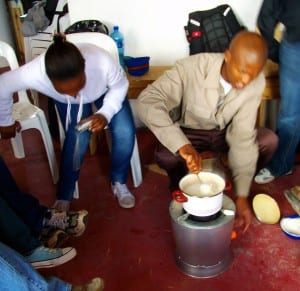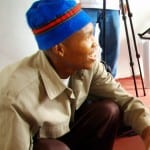Methodology
Methodology
Mission and Objectives
The primary goal of this project was to offer a better means of cooking for the residents of Monwabisi Park, South Africa that will best satisfy the following criteria: safe, healthful, accessible, inexpensive, socially acceptable, and sustainable. We also looked to teach members of the community ways to reduce energy consumption that will better their health and safety with respect to energy use. Our objectives were as follows:
- Understand the existing energy practices in Monwabisi Park.
- Plan and design sustainable and healthful alternatives to current cooking methods.
- Test and present the new alternatives to the community for feedback.
- Develop a plan for making these alternatives available to the community.
In order to accomplish our objectives, we followed a methodology of researching, testing in the community, and giving recommendations. First we established a relationship with the co-researchers which then helped us to interact with the community. The information we learned through interviews helped us determine our course of action which narrowed down our scope to finding a safe way to cook with paraffin. We then tested the options we discovered through research and presented the ideas to the community.
Co-Researchers
Last year the co-researcher program was established to assist the students in their research and understanding of Monwabisi Park. Because most of the residents of Monwabisi Park speak Xhosa as their primary language a translator is needed occasionally to help communicate with the residents. In addition to acting as translators, the co-researchers provide a level of safety to the students and comfort to the residents being interviewed. Through the co-researcher program, our team was able to work closely with a member of the community who has helped us in our research throughout the term. Our relationship with the co-researchers, particularly with Siya Magada, has been a key component of our project. Siya contributed to our project as a true collaborator, helping us to think about the issues and understand the perspectives of the people. He also was an active participant in trying different stoves and pre-testing our surveys to make sure that they were clear. He was also an important addition to our presentations to the community. Through our ties with Siya, we were able to efficiently use our time when in the park doing research. During our first week in Monwabisi Park our project consisted of interviewing the residents and gauging their opinions on heating and cooking. We interviewed ten residents with varying house sizes, from one to seven residents, and determined their cooking and heating sources. The personal relationship that we forged early on with Siya caused him to take a specific interest in our project that was beneficial to both parties. The interview process was easier because of his outgoing personality. He knew many members of the community, all of whom were willing to help us.
Interviews and Surveys
During our first few days in Monwabisi Park, we interviewed residents who cooked with paraffin, electric, and gas stoves in order to learn more about each stove and its use. We asked them how much it cost to cook with each of their stoves (both what the stove itself cost and its fuel for regular use), what they typically cooked and how long it took them to make it, and if they had any concerns with their current stoves. From these interviews, we learned how imperative it was the we find a solution for cooking rather than for heating, and got a better sense of how crucial both affordability and accessibility would be for the sustainability of the solution.
We also gave ten families a survey to fill out for a week. We tried to get surveys from people using each of the different stoves, electric, primus, flame, and gas. This survey had questions aimed at quantifying cooking patterns and associated paraffin costs. This “cooking profile” helped us better see how much money residents actually spend on cooking every week so that we can evaluate energy costs and potential savings.
For more details from the interviews click HERE.
Narrowing Down Options for Cooking
After conducting interviews and surveys in the community, we determined that it would be most useful for us to focus on cooking practices. Originally, our focus included home heating, but after speaking with members of the community we soon realized that cooking was a larger concern. Thus we narrowed our focus to cooking only. Before arriving in Cape Town, we proposed a Rocket Stove (an efficient wood burning stove) as a viable option. However, once we got to the community we found that locating wood would be a challenge. We also looked into Gel Fuel; however, upon more research we determined that it would not be a cost effective solution. Ultimately we decided to look more into safe paraffin stoves since paraffin is affordable and readily available in Monwabisi Park.
For information on other sustainable options, click HERE.
 Community Testing
Community Testing
We handed out the Arivi Safe Paraffin Stove to ten randomly selected residents in Monwabisi Park to test by using it to cook their meals for the night. We gave them surveys to fill out while cooking so that we would know how long they cooked, what they cooked, what they like and dislike about the stove, how much money they would be willing to buy it for, and any other comments or information they would like us to know. When we met with the residents the following day to get the stove back, we asked them if they liked using the stove and asked them how it compared to the stove they were currently using. It was very helpful to see what different community members thought about the stove, and different perspectives brought important aspects of the stove (such as any smells, difficulties, and favorable features) to our attention
Presentation
Lastly, we presented the Arivi and ParaSafe stoves to the community at two local store owners’ shops. Using Siya as a translator, we explained who we were, demonstrated the use of each stove as well as their safety features, and boiled water to demonstrate the efficiency of the stoves. During the presentation, we were able to answer any questions that residents had and learned about their concerns. The presentations were successful; they stimulated interest in the safer stoves and encouraged safer practices with current stoves. We also noted that there was significantly greater interest in the Arivi Stove than the ParaSafe Stove.
For more information on our presentations, click HERE.



